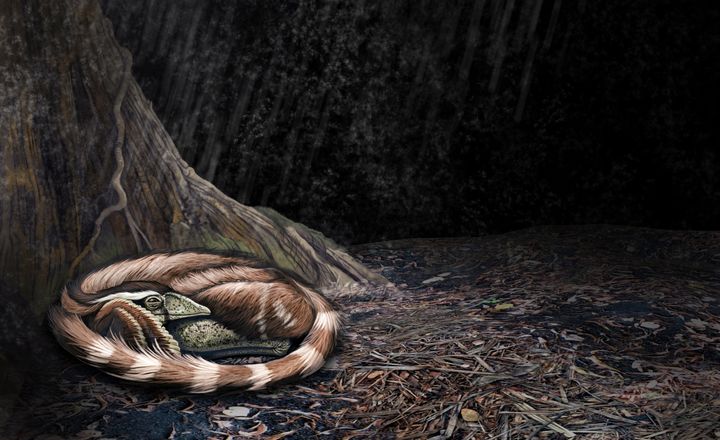
It turns out we may have more in common with reptiles -- and even dinosaurs -- than we previously thought.
A new study, published in the journal Science on Thursday, monitored brain activity in lizards using a new technique and found that when the reptiles snooze, they cycle through REM and slow-wave sleep patterns just like mammals and birds do. And dinosaurs probably did the same.
The findings suggest that animals started experiencing these stages of sleep much earlier than previously thought, Dr. Gilles Laurent, director at the Max Planck Institute for Brain Research in Frankfurt, Germany, and co-author of the study, told The Huffington Post.
"The results were indeed surprising, because the prevailing view has been that REM and slow-wave sleep are limited to mammals and birds, excluding non-avian reptiles," Laurent said. That theory would have had REM and slow-wave sleep evolving closer to the time when modern feathered birds first emerged (about 100 million years ago) and placental mammals first appeared (about 65 million years ago), Laurent said.
But the new findings suggest that REM and slow-wave sleep patterns just may be as old as the common ancestor shared by mammals, birds and reptiles -- the first amniotes -- that lived about 300 million years ago (back when the Earth’s continents were all one land mass), Laurent said.
Reptiles Sleep In Two Phases, Too
The researchers implanted a type of silicon probe in the forebrain regions of five Australian bearded dragons, or Pogona vitticeps, that tracked brain activity as the reptiles slept. The probes were a new type of device that allowed for deeper recordings of brain activity than had been previously used, Laurent explained.
The researchers also monitored eye movement of the lizards while they slept using infrared cameras and computerized video analysis.
The recordings showed that the reptiles sleep in two phases, one with low-frequency, high-amplitude brain activity and the other with awake-like brain activity and rapid eye movements -- which are similar to the slow-wave and REM sleep stages of mammals and birds, Laurent said.
"[The study provided] extremely strong evidence that the patterns of structure of sleep that we’ve seen in a broad range of species is reflective of something that evolved very early in vertebrate evolution and is shared across many — perhaps all — vertebrates," Dr. Daniel Margoliash, a professor of organismal biology and anatomy at the University of Chicago who was not involved in the study, told The New York Times.
However, the finding that these reptiles have REM and slow-wave sleep cycles like humans does not mean that mammals, birds and reptiles are any more closely related than scientists thought, Laurent said. It’s important to clarify that reptiles, mammals and birds still do sleep pretty differently.
Lizard Sleep Cycles Are Only About 80 Seconds
Besides the fact that humans like to cozy up in cotton sheets and (whenever possible) sleep after a warm bubble bath, humans also have longer sleep cycles and deeper slow-wave sleep than other animals. For instance, human sleep cycles tend to be between 60 and 90 minutes, while cat sleep cycles are about 30 minutes and the lizards’ sleep cycles, according to these new findings, were as quick as 80 seconds, Laurent said.
The researchers also noticed that the lizards’ sleep cycles had roughly equal parts REM and slow-wave sleep, whereas REM sleep in the human cycle tends to be shorter than slow-wave sleep and irregular in birds.
If The Theory Is True, Dinosaurs Probably Had REM Cycles, Too
If REM and slow-wave sleep are as old as these findings suggest, it is very likely that dinosaurs would also have had REM and slow-wave sleep cycles, too, as dinosaurs lived during the Mesozoic Era some 230 to 65 million years ago, Laurent said.
Why do scientists care how dinosaurs and other ancient creatures sleep? The research helps to answer questions about why animals follow sleep rhythms and what purpose they serve, Laurent said: "Do they play a role in information transfer between brain areas and in memory consolidation?"
Such findings could help reveal how sleep -- in the way that we do it today -- started and why, Laurent added.
"What did brain sleep evolve for?" he asked. "Did it start off with completely different functions linked to the constraints of the day -- circa 320 million years ago or earlier?"
Sarah DiGiulio is The Huffington Post’s sleep reporter. You can contact her at sarah.digiulio@huffingtonpost.com.

